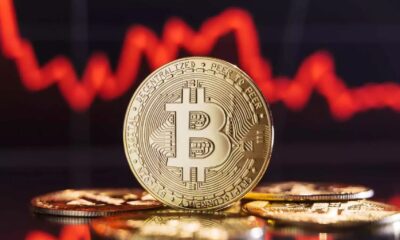Adoption
Swiss lawmakers to study Bitcoin for power grid upgrade
Published
6 months agoon
By
admin

Swiss policymaker Samuel Kullmann secured a sweeping majority vote for a Bitcoin mining study aimed at optimizing local power infrastructure.
According to Bitcoin (BTC) advocate Dennis Porter, Kullmann’s proposal passed on Nov. 28 and could steer Switzerland toward BTC adoption.
The Bitcoin policy will now explore how the world’s largest decentralized proof-of-work blockchain can stabilize the Swiss energy grid and “use otherwise wasted energy.” Kullmann’s proposal passed following an 85:46 vote in Switzerland’s Parliament.
The Swiss trek to Bitcoin
Policy around Bitcoin in Switzerland comes as no surprise, as the BTC halving proved massive interest from Swiss citizens. Zurich, the largest Swiss city, ranked top for BTC halving searches on Google, crypto.news reported in April.
Despite U.S. spot BTC exchange-traded fund approval months prior, Europe dominated Google queries for info on the trillion-dollar cryptocurrency and its code changes. The BTC mining reward is cut by 50% every four years to maintain scarcity and contain inflation.
Back in August, financial records revealed that the Swiss Central Bank bought MicroStrategy shares. As the largest corporate BTC holder with a $35 billion treasury, buying MSTR may afford investors indirect exposure to the trending digital asset.
Global adoption
BTC policy accelerated worldwide in 2024, coinciding with growing global inflation concerns and greater institutional demand for BTC. Lawmakers in the U.S. and Brazil both proposed creating strategic national BTC reserves.
Vancouver’s Mayor Ken Sim also argued for diversifying the city’s investments by holding BTC on its sovereign balance sheet. Corporations in corners of the globe allocated millions of dollars to BTC treasuries, following the model established by Michael Saylor’s software giant.
Source link
You may like


Dems Say They’re Blocked From Info on Verge of Crypto Market Structure Bill Hearings


Dow gains 214 points, markets end higher as strong labor data eases tariff concerns


Ethereum Price Headed For Crash To $2,000 With Current Price Action


Tokenized funds hit $5.7B, scaling fast — Moody’s


Authorities Warn of Phony Text Messages Phishing for Sensitive Information, Telling Victims Their Bank Account Is at Risk


Tether invests in Chilean crypto exchange Orionx

For years, Bitcoin in Ireland has quietly simmered at the grassroots level—discussed in pubs and meetups, debated in Telegram groups, and occasionally splashed across headlines with predictable suspicion. But recently, the temperature is beginning to rise. With the release of “A Sound Punt: The Case for Ireland’s Interest in Bitcoin” by Bitcoin Network Ireland (BNI), and a weekend that sees both the Bitcoin Ireland Conference and Aontú’s Ard Fheis, it’s clear momentum is building on the Emerald Isle.
A Sound Punt: A Paper for the Citizens of Ireland
The new paper, released today by Bitcoin Network Ireland, is a concise, accessible document crafted to cut through the noise and present the merits of Bitcoin to the general public and politicians alike. Its aim is straightforward: provide a rational, jargon-free entry point into why Bitcoin matters, especially in an era of euro debasement and rising living costs.
The name itself is a clever pun—while it is a nod to both “sound money” and Ireland’s former currency, the punt, it also playfully suggests that although the majority of people view it as associated with risk, this may be worth reevaluating. It’s a signal that this is about more than technology: it’s about claiming monetary sovereignty and re-examining what makes money “good” in the first place.
What BNI is attempting to accomplish is bridging an important gap in understanding, helping citizens seeking change and government officials looking for solutions to recognize that sound, stateless money has value for everyone. As Parker Lewis famously noted, “Like all successful monies, Bitcoin is money for enemies“—a neutral system that serves all participants regardless of their political stance.
Ireland’s Long and Complicated Relationship With Money
To appreciate the significance of this moment, it’s worth noting that Ireland’s relationship with money has always been distinct from its European neighbors. While the Romans introduced coinage to Britain over a thousand years before it was adopted in Ireland. The native Irish resisted state-issued money, relying instead on barter and bullion well into the second millennium.
In ancient Ireland, the absence of coinage was a testament to a society that was stateless, highly decentralised, and it embraced a polycentric legal system varying between clans. The ideal of that society was that no man in society has rule over others, and even kings could be disposed of if they abused their power.
So it’s perhaps no coincidence that Ireland was the last European society to adopt coinage, as coinage gives power to rulers. Eventually, it was forced upon the land by the English crown in 1601, this period coincided with the final stages of the Nine Years’ War (1594-1603) and the increasing English control over Ireland. To this day, Ireland has never had its own free-floating currency; it has always been tethered to external powers: first the pound sterling, then the European Monetary System, and now the euro under the ECB. So it should come as no coincidence that in recent years, the EU is growing unabated in power and influence over Ireland.
“Give me control over a nation’s currency, and I care not who makes its laws.” — Mayer Amschel Rothschild (1743–1812)
Perhaps, given this historical context, Ireland is uniquely positioned to understand the value of sound, stateless money. Bitcoin represents a return to the monetary independence that preceded state-issued currencies, but with the technological advantages of the digital age. Where ancient Irish kingdoms used market goods that couldn’t be manipulated by distant authorities, Bitcoin offers a modern equivalent: a system that can’t be debased or controlled by any power, whether domestic or foreign.
This historical skepticism toward centrally-controlled currency is resurfacing in the present, as the Irish state and its citizens face a new wave of economic uncertainty via euro debasement and tariffs. Geopolitical and economic tensions have rarely felt less stable. Tariff disputes, renewed questions over Ireland’s foreign direct-investment model, and potential tech and pharma layoffs are sure to sharpen the focus on sovereignty and resilience. The release of “A Sound Punt” is timely, inviting the nation to once again question the wisdom of tying its fortunes to distant monetary authorities.
A Political Crossroads
Coinciding with the release of “A Sound Punt,” Dr. Niall Burke—a respected academic and BNI member—will be putting forward two motions at the Aontú Ard Fheis (party conference). Aontú, the party that saw the largest surge in votes in the last general election, has shown itself to be receptive to Bitcoin and is opening its doors to conversations that, until recently, were relegated to the margins. That Bitcoin motions are being presented and accepted at a major party conference is a marker of how the conversation is turning.
Meanwhile, the Bitcoin Ireland Conference is gathering the country’s growing community of plebs, builders, and advocates. These circles, once on the periphery, are now finding doors opening in political circles.
Public Discontent and a Call for Financial Autonomy
It’s not just Bitcoiners who are seeking alternatives. Ireland is witnessing its largest public demonstrations since the post-GFC days of 2012. Recent marches have drawn in excess of 100,000 people to the streets of Dublin. These protests reflect deep frustration and a sense that the political establishment is no longer in alignment with its people.
What’s particularly striking is how Bitcoin could serve as common ground for seemingly opposing interests. For protesters, Bitcoin offers protection from inflation and defends against government overreach. For a government concerned about economic stability and growth, Bitcoin may be the very solution it needs, especially to protect pension funds and indeed the state’s very own investment fund—ISIF, from inflation over the coming decades. This is the paradox and promise of sound, stateless money. It serves everyone’s interests because it enforces property rights, and can’t be captured or controlled by any single faction.
Last, but not least, MMA star Conor McGregor’s foray into both politics and Bitcoin is something few would have predicted a year ago, but for those with an ear to the ground, this has been a developing story for some time. His proposal for a national Bitcoin reserve is emblematic of a broader national shift: Bitcoin is finally entering the Zeitgeist and perhaps he, like BNI, has a part to play in keeping it there.
Bitcoin is an open-source monetary protocol, and adoption comes from all quarters, irrespective of politics. Bitcoin is neutral, it supports no partisan cause. What’s perhaps not recognized enough is how empowering Bitcoin can be and we should focus on its ability to unite rather than divide, giving every Irish citizen—regardless of their political views—tools for individual liberty, inflation protection, as well as practical solutions for businesses.
Back to “A Sound Punt” Paper
The paper itself makes a compelling case for Ireland’s interest in Bitcoin:
- Sound Money Principles: It evaluates Bitcoin against the six characteristics of “good money”—durability, divisibility, uniformity, portability, verifiability, and scarcity.
- Store of Value: The document highlights Bitcoin’s fixed supply as protection against rising inflation and currency debasement.
- Practical Examples: It provides evidence of Bitcoin’s monetization, comparing the costs of buying a home in Euros vs. Bitcoin over the span of a decade.
- Common Concern Rebuttals: The paper addresses the most common objections to Bitcoin—energy usage, volatility, criminal activity, undermining traditional currencies, and speculation—offering balanced counterarguments to each.
- Action Steps: Rather than just theoretical arguments, the paper outlines specific actions for individuals, businesses, and the government to consider, from education to strategic Bitcoin reserves.
The Beginning of a Process
No one expects the Irish government to announce a Bitcoin treasury next week, and it’s debatable whether it should establish one at all. But “A Sound Punt” marks the beginning of a process that could, in time, help reshape Ireland’s approach to money and economic sovereignty.
This accessible primer is just the first step in Bitcoin Network Ireland’s broader educational mission. BNI plans to publish a much more comprehensive policy paper for policymakers in the coming months, which is currently going through the editing phase. While “A Sound Punt” introduces the concepts to the general public, the forthcoming document will provide the detailed analysis and policy recommendations that decision-makers need.
As BNI works to elevate this conversation through both public education and policy analysis, the goal remains clear: helping all citizens recognize Bitcoin’s universal value proposition. Holding a modest strategic allocation of bitcoin—at either the individual or institutional level—offers some protection against uncertainty and hope in a time of growing concerns.
Download A Sound Punt: The Case for Ireland’s Interest in Bitcoin from the Bitcoin Network Ireland website.
Source link
Adoption
BitMine Launches Bitcoin Treasury Advisory Practice, Secures $4M Deal With First Client
Published
2 weeks agoon
May 20, 2025By
admin
Today, BitMine Immersion Technologies, Inc. (OTCQX: BMNRD) announced the launch of its Bitcoin Treasury Advisory Practice and a $4 million deal with a U.S. exchange-listed company. The deal saw Bitmine surpass its last year’s total revenue in that single transaction alone, according to the announcement.
BitMine will provide “Mining as a Service” (MaaS) by leasing 3,000 Bitcoin ASIC miners to the client through December 30, 2025, in a $3.2 million lease deal, with $1.6 million paid upfront. Additionally, the client has signed an $800,000 consulting agreement for one year focusing on Bitcoin Mining-as-a-Service and Bitcoin Treasury Strategy.
“Currently, there are almost 100 public companies that have adopted Bitcoin as a treasury holding. We expect this number to grow in the future. As more companies adopt Bitcoin treasury strategies, the need for infrastructure, revenue generation, and expert guidance grows along with it,” said Jonathan Bates, CEO of BitMine. “This single transaction is greater than our entire 2024 fiscal year revenue, and we feel there is an opportunity to acquire more clients in the near future as interest in Bitcoin ownership grows.”
BitMine’s first quarter 2025 results showed strong revenue growth, with GAAP revenue rising approximately 135% to $1.2 million, up from $511,000 in Q1 2024, supported by an expanded mining capacity of 4,640 miners as of November 30, 2024, compared to 1,606 the previous year. Despite this growth, the company reported a net loss of $3.9 million in Q1 2025, primarily due to a one-time, non-cash accounting adjustment related to preferred stock; excluding this charge, the adjusted loss was approximately $975,000, consistent with the prior year’s results.
BitMine’s new Bitcoin Treasury Advisory Practice, along with the $4 million deal, joins a trend among public companies exploring Bitcoin not just as a treasury asset but also as a source of revenue.
Source link

A Strategic Bitcoin Reserve is a designated accumulation of Bitcoin (BTC) held by a government, institution, or corporation to secure financial stability, hedge against inflation, and reinforce economic sovereignty. Similar in function to gold or foreign exchange reserves, it leverages Bitcoin’s fixed supply, decentralization, and global liquidity to mitigate economic and geopolitical risks.
What is a Strategic Bitcoin Reserve
A Strategic Bitcoin Reserve (SBR) represents a deliberate holding of Bitcoin by national governments or large corporations as part of their strategic financial reserves. Rather than speculative investment, the goal is long-term economic protection and resilience, particularly against inflationary pressures and currency devaluation inherent in fiat monetary systems. An SBR serves as a diversification strategy, integrating Bitcoin’s unique characteristics—limited supply, censorship resistance—into established financial management practices.
Key Takeaways
- Holding Bitcoin as part of a strategic reserve can strengthen financial stability and hedge against fiat currency risks.
- Bitcoin’s fixed supply of 21 million coins enhances its appeal as a deflationary, long-term asset.
- Institutional and governmental adoption of Bitcoin reserves is growing, with key examples including the United States, Strategy (formerly MicroStrategy), Metaplanet, and others.
- Incorporating Bitcoin into reserves reflects a broader shift toward financial modernization, decentralization, and economic sovereignty.
Purpose
A Strategic Bitcoin Reserve serves several important functions. First of all, it provides a buffer against economic instability by mitigating the impact of inflationary monetary policies often associated with fiat currencies. It also strengthens financial sovereignty by reducing a nation’s or institution’s reliance on traditional banking systems and centralized financial institutions. Additionally, Bitcoin offers a unique opportunity for asset diversification, as its fixed supply, decentralized nature, and digital infrastructure make it an appealing and resilient store of value in modern reserve management.
History
The concept of a Strategic Bitcoin Reserve gained prominence in the early 2020s as Bitcoin’s adoption expanded. The pivotal moment occurred in March 2025 when the U.S. President Donald J. Trump signed an executive order establishing the nation’s SBR. The initiative aimed to leverage Bitcoin’s fixed supply and decentralized nature to enhance national financial resilience.
The foundation for state-level Bitcoin adoption was laid earlier by El Salvador, which became the first country to declare Bitcoin legal tender in 2021 and began accumulating Bitcoin for national reserves. Though not officially labeled a Strategic Bitcoin Reserve, the country’s approach set a precedent for sovereign Bitcoin holdings as a monetary strategy.
Notable Examples
El Salvador
In 2021, El Salvador became the first country in the world to adopt bitcoin as legal tender and began acquiring bitcoin for national holdings. While not formally labeled a Strategic Bitcoin Reserve, the government’s ongoing accumulation strategy, including daily purchases announced by President Nayib Bukele, closely resembles the principles of an SBR. El Salvador’s move set a global precedent for sovereign Bitcoin adoption and laid the foundation for future reserve strategies.
United States
In 2025, the U.S. government formalized its bitcoin holdings into a Strategic Bitcoin Reserve, utilizing assets acquired through legal forfeitures. This move underscored a shift in policy, recognizing bitcoin’s potential as a strategic asset and aligning with broader efforts to modernize the nation’s financial infrastructure.
Strategy (formerly MicroStrategy)
Since 2020, Strategy has been at the forefront of corporate Bitcoin adoption, amassing over 500,000 BTC by 2025. The company employed innovative financial instruments, such as convertible bonds and preferred stock, to fund its acquisitions, positioning itself as a pioneer in integrating Bitcoin into corporate treasury strategies.
Metaplanet Inc.
Japanese firm Metaplanet adopted Bitcoin as its primary treasury reserve asset, issuing bonds to finance its purchases. By April 2025, the company held over 4,500 BTC, with plans to increase its holdings to 10,000 BTC by the end of the year. Metaplanet’s strategy reflects a growing trend among corporations to leverage Bitcoin for long-term financial stability.
How it Works
A Strategic Bitcoin Reserve (SBR) functions through several interrelated components. These range from how the Bitcoin is acquired, funded, stored, and governed, to how it is ultimately used as part of a long-term sovereign or institutional strategy.
1. Purchase and Allocation
The first step in establishing a Strategic Bitcoin Reserve is making the decision to formally allocate a portion of national or institutional capital to Bitcoin. This may involve passing legislation, updating reserve management policies, or assigning authority to a designated treasury or finance department.
Once the decision is made, accumulation typically follows a structured, phased approach to minimize market disruption and maintain financial stability. For example, the BITCOIN Act, introduced in July 2024 by U.S. Senator Cynthia Lummis, proposes that the federal government acquire one million BTC over five years, divided into four tranches of 250,000 BTC. This staggered model offers flexibility to time acquisitions in response to market conditions and broader economic developments, while funding would come from seized bitcoins, surplus Federal Reserve funds, and revalued gold certificates.
2. Funding Sources
To avoid burdening taxpayers or increasing public debt, strategic reserves can draw from various funding methods:
- Seized Bitcoin: Often originating from asset forfeitures or regulatory actions, such as those previously held as part of legal settlements or enforcement actions. (eg: Silk Road, Bitfinex)
- Revalued gold certificates: The U.S. Treasury holds certificates backed by physical gold that, if marked to market, could unlock hundreds of billions in value.
- Federal Reserve surplus: Surplus capital from the Federal Reserve can be redirected without impacting ongoing monetary operations.
These approaches offer flexibility and reduce the risk of politically contentious spending measures.
3. Legislative Framework and Oversight
Reserves like the U.S. Strategic Bitcoin Reserve require formal legislation to ensure public trust and legal clarity. The BITCOIN Act serves as one such framework. It sets:
- Limits on annual bitcoin purchases.
- Conditions under which bitcoin can be sold (e.g., only to pay off federal debt).
- Requirements for reporting, audit, and public disclosure.
This legal architecture creates predictability and institutional accountability.
4. Secure Storage
Securing bitcoin under a Strategic Bitcoin Reserve (SBR) presents unique challenges that go beyond traditional asset management. Because bitcoin is a bearer instrument, control of the private keys equates to control of the funds. Entrusting those keys to a single individual — or even a small group — creates significant risks, both to the reserve itself and to the people involved. Individuals may simply not want that level of responsibility, as the personal and legal risks are extraordinarily high. A failure, hack, or even a misstep could have catastrophic consequences, making sole or concentrated custody an impractical and dangerous solution.
To mitigate these risks, an SBR would likely consider an institutional-grade multisignature custody model. This setup allows for the distribution of keys across multiple, independent parties, requiring quorum-based authorization (e.g., 3-of-5 or 5-of-7) to approve transactions. By separating key holders geographically and across trusted institutions — such as treasury departments, independent auditors, or allied entities — this approach minimizes the chance of compromise while enhancing resilience and accountability. It also aligns more closely with Bitcoin’s foundational principle of decentralization, ensuring that no single actor has unilateral control over the nation’s reserve.
5. Long-Term Holding Mandate
A key feature of strategic reserves is the duration of the hold. The U.S. proposal suggests a 20-year minimum, preventing short-term political or economic disruptions from influencing management.
Bitcoin may only be sold under specific circumstances—such as debt reduction—ensuring the reserve functions as a stable store of value rather than a speculative asset. This provides policy consistency across different administrations.
6. Strategic Utility and Integration
Once in place, the reserve becomes part of a broader national financial strategy. It may be:
- Used as collateral for sovereign borrowing.
- Held alongside gold, oil, and foreign exchange reserves to diversify risk.
- Leveraged diplomatically during geopolitical negotiations or economic partnerships.
The SBR thus serves both a defensive and offensive role—protecting domestic purchasing power while enabling financial innovation and strategic influence.
Related Terms
- Bitcoin (BTC): A decentralized digital currency with a fixed supply of 21 million coins, operating on blockchain technology.
- Cold Storage: Secure, offline methods for storing cryptocurrencies to prevent unauthorized access.
- Multi-signature Wallet: A cryptocurrency wallet that requires multiple keys to authorize transactions, enhancing security.
- Fiat Currency: Government-issued currency not backed by a physical commodity, such as the US Dollar or Euro.
Why Bitcoin is Being Considered as a Strategic Reserve
Bitcoin is gaining attention as a strategic reserve asset due to its fixed supply, decentralization, and resilience. With only 21 million coins ever to exist, Bitcoin offers a deflationary counterpoint to fiat currencies that are regularly expanded through monetary stimulus.
Its decentralized design—free from any central authority or leadership—instills confidence in its neutrality. Satoshi Nakamoto, the anonymous creator, walked away from the project in 2010, leaving behind a system governed by code and distributed consensus. This absence of leadership makes the network more resistant to censorship, political pressure, or manipulation.
Bitcoin’s market capitalization has grown to the point where corporations and governments now view it as large and liquid enough to consider for reserves. As trust in traditional monetary systems declines, bitcoin is increasingly seen as a viable hedge.
The current fiat system may be approaching its endgame—overextended by debt and distortion. If the system cracks, Bitcoin could be a legitimate financial fallback: a bearer-based, censorship-resistant monetary asset outside the reach of central banks.
Bitcoin also offers transparency, programmability, and auditability—qualities that position it as a serious contender in future monetary and reserve strategies.
How Likely Is the U.S. Strategic Bitcoin Reserve?
The U.S. Strategic Bitcoin Reserve Is No Longer a Hypothesis
With the national debt surpassing $35 trillion and the limitations of traditional monetary policy becoming increasingly evident, the U.S. has taken decisive action by formally establishing a Strategic Bitcoin Reserve. This development, announced via an executive order in March 2025, confirms that the federal government views bitcoin not merely as an emerging asset, but as a critical component of long-term fiscal and strategic planning.
This move is symptomatic of the convergence of economic and geopolitical factors:
- Game-Theoretic Pressure: As it is thought that some nations are quietly accumulating bitcoin, the U.S. won’t want to risk falling behind in a finite-asset race. Early adoption is now a strategic imperative.
- Sovereign Resilience: Bitcoin’s immunity to censorship, seizure, and monetary debasement makes it uniquely suited for sovereign reserves in an increasingly fragmented global financial system.
- Market Maturity: Bitcoin’s deepening liquidity and growing market cap now meet the thresholds required for sovereign-level acquisition without destabilizing the market.
- Cross-Party Support: The reserve has drawn backing from across the political spectrum—appealing both to advocates of fiscal discipline and to supporters of decentralized, non-state monetary systems.
With the Strategic Bitcoin Reserve now a matter of policy, attention will increasingly turn to its execution—particularly how it is funded, how custody is managed, and how acquisition is phased to avoid disrupting markets. The foundation has been laid; the next challenge is implementation at scale.
FAQs
How is a Strategic Bitcoin Reserve different from corporate bitcoin holdings?
While both may involve large, long-term holdings, the key difference lies in purpose and scope. A Strategic Bitcoin Reserve—especially at the state level—is held to enhance national economic resilience, hedge against sovereign currency risk, and support strategic autonomy. Corporate holdings, by contrast, are usually governed by fiduciary obligations and focused on optimizing balance sheets or shareholder returns. That said, some corporations like Strategy or Metaplanet blur this line by explicitly framing their bitcoin holdings as core to long-term strategic treasury planning.
What risks are associated with a Strategic Bitcoin Reserve?
Primary risks include Bitcoin’s market volatility, cybersecurity threats, regulatory uncertainties, and potential political opposition domestically or internationally.
How Will a Strategic Bitcoin Reserve Impact BTC Price?
Establishing an SBR at the sovereign level could exert significant upward pressure on Bitcoin’s price, especially given its fixed supply. Large-scale purchases by governments or state institutions would reduce available supply, potentially driving greater demand and long-term valuation increases. Market participants may also front-run anticipated purchases, compounding volatility in the short term.
Is a Bitcoin Reserve a Good Idea?
The cypherpunks and early Bitcoin adopters—those who valued Bitcoin as a tool for personal sovereignty and separation of money from state—may view the concept of a government-controlled Bitcoin reserve with deep skepticism, as Bitcoin was built to be outside the reach of centralized power. State-level reserves risk inviting political capture, custodial control, or dilution of Bitcoins core ethos.
Yet, others may find merit in governments adopting Bitcoin as a monetary hedge. From this perspective, it reinforces individual liberty through sound money principles and offers a way for governments to reduce dependence on inflationary fiat systems. It also positions bitcoin as a reserve asset in a multipolar world of competitive currencies.
From a pragmatic angle, securing a bitcoin reserve can enhance monetary resilience, accelerate adoption, and demonstrate forward-thinking financial strategy. It helps governments hedge against fiat debasement and increases their credibility amid rising sovereign debt and central bank distrust.
Ultimately, if Bitcoin is to serve as the next global reserve money, then individuals, institutions, and governments alike will need to hold some. The central question isn’t whether governments will adopt it—but how bitcoin will be distributed and accessed, and whether its foundational principles can be preserved in the process.
Takeaway
The rise of Strategic Bitcoin Reserves marks a turning point in how governments, corporations, and institutions approach long-term economic security. Bitcoin’s immutability, neutrality, and fixed supply make it fundamentally different from traditional reserve assets—globally accessible, apolitical, and digitally native.
We are witnessing game theory in action. Often, actors wait for external validation before taking bold steps—and there is no greater signal than the United States of America strategically stockpiling bitcoin. This not only grants implicit permission for others to follow, but also communicates long-term belief in Bitcoin’s value.
Its adoption reflects a growing recognition that the fiat system may be nearing exhaustion. In this context, bitcoin is more than an asset—it’s a hedge, a strategic benchmark, and a potential backbone for future monetary systems.
The question is no longer if reserves will be established—but how they will be structured, secured, and balanced with the principles that made Bitcoin valuable in the first place: openness, decentralization, and individual sovereignty.
Source link
Dems Say They’re Blocked From Info on Verge of Crypto Market Structure Bill Hearings

Dow gains 214 points, markets end higher as strong labor data eases tariff concerns
Ethereum Price Headed For Crash To $2,000 With Current Price Action
Tokenized funds hit $5.7B, scaling fast — Moody’s
Authorities Warn of Phony Text Messages Phishing for Sensitive Information, Telling Victims Their Bank Account Is at Risk

Tether invests in Chilean crypto exchange Orionx

MARA Hits Record-High Bitcoin Production in May
Retail investors no longer FOMO into BTC, altcoins
AVAX Rises 3.8% on Strong Volume, Breaking Key Resistance Levels

K33 begins Bitcoin buying with 10 BTC purchase for treasury strategy
Why $107,500 And $103,500 Are The Levels To Watch
Pakistan Proposes New Crypto Regulations
Japanese Bitcoin Hoarder Metplanet Adds $115,600,000 Worth of BTC As Stock Surpasses 263% Gains on the Year
Bitcoin traders anticipate decline, watch $100K
Ethereum Foundation Restructures R&D Division, Plans ‘Rethink’ on Design and Development

Arthur Hayes, Murad’s Prediction For Meme Coins, AI & DeFi Coins For 2025

Pi Network coin to $10? 4 catalysts that may make it possible

3 Voting Polls Show Why Ripple’s XRP Price Could Hit $10 Soon

Expert Sees Bitcoin Dipping To $50K While Bullish Signs Persist

Aptos Leverages Chainlink To Enhance Scalability and Data Access

Bitcoin Could Rally to $80,000 on the Eve of US Elections

Crypto’s Big Trump Gamble Is Risky

The Future of Bitcoin: Scaling, Institutional Adoption, and Strategic Reserves with Rich Rines

Institutional Investors Go All In on Crypto as 57% Plan to Boost Allocations as Bull Run Heats Up, Sygnum Survey Reveals

Sonic Now ‘Golden Standard’ of Layer-2s After Scaling Transactions to 16,000+ per Second, Says Andre Cronje

Ripple-SEC Case Ends, But These 3 Rivals Could Jump 500x

Has The Bitcoin Price Already Peaked?

A16z-backed Espresso announces mainnet launch of core product

Blockchain groups challenge new broker reporting rule

Xmas Altcoin Rally Insights by BNM Agent I
Trending

 24/7 Cryptocurrency News7 months ago
24/7 Cryptocurrency News7 months agoArthur Hayes, Murad’s Prediction For Meme Coins, AI & DeFi Coins For 2025

 Markets3 months ago
Markets3 months agoPi Network coin to $10? 4 catalysts that may make it possible

 Ripple Price3 months ago
Ripple Price3 months ago3 Voting Polls Show Why Ripple’s XRP Price Could Hit $10 Soon

 Bitcoin5 months ago
Bitcoin5 months agoExpert Sees Bitcoin Dipping To $50K While Bullish Signs Persist

 24/7 Cryptocurrency News5 months ago
24/7 Cryptocurrency News5 months agoAptos Leverages Chainlink To Enhance Scalability and Data Access

 Bitcoin7 months ago
Bitcoin7 months agoBitcoin Could Rally to $80,000 on the Eve of US Elections

 Opinion7 months ago
Opinion7 months agoCrypto’s Big Trump Gamble Is Risky

 Bitcoin4 months ago
Bitcoin4 months agoThe Future of Bitcoin: Scaling, Institutional Adoption, and Strategic Reserves with Rich Rines


